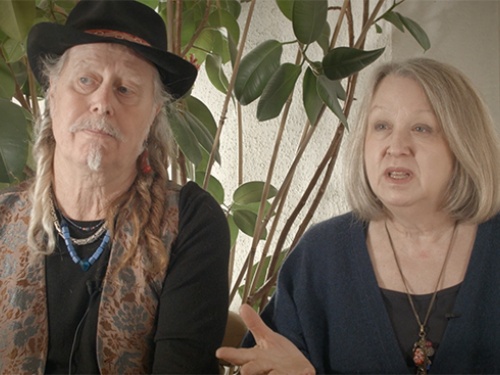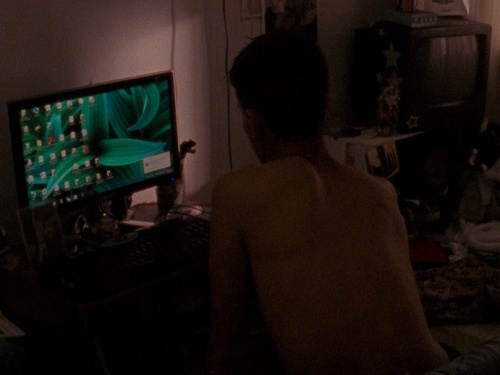Dancing on Ice: An Interview with André Semenza and Fernanda Lippi
Ahead of the Sea Without Shore screening and Q&A, directors André Semenza and Fernanda Lippi shared their thoughts about the relationship between poetry and dance, and the experience of filming in freezing conditions.
How did the idea for this project develop?
Sea Without Shore developed in the rehearsal room. As Fernanda worked with one of our dancers, Livia, the story of a relationship between two women began to unfold.
The process of making this film was akin to that of devised theatre: as things happened in the studio, we assembled the elements to build a theme and dramatic material. We were in constant discussion, deciphering the developments and their potential meaning – a very intuitive process.
The film follows an intense love affair between two 19th century women that is abruptly cut short. What drew you to this story in particular?
The disappearance of a loved one and the desire to be reunited was at the core of what we wanted to explore. We knew we had captured something real - the result was experiential, a living thing. Our work is always driven by somatic and intuitive choices. Easy answers and simple plot lines wouldn’t do its mysteries justice.
Working on the voiceover narration, I researched volumes of lesbian literature, such as Algernon Charles Swinburne’s Anactoria, Katherine Philips and Renée Vivien. We lived with these fascinating poets for years. So, rather than seeking out this theme, it gradually enveloped us. Bringing the poetry to the film was a selective process of recording lines multiple times and marrying them to scenes - some would fit exhilaratingly well, others would drop away for good.
How was the experience of working in Sweden?
When we got to the location, the impact on the choreographic motifs was dramatic. Sweden’s breathtaking winter landscape with extremely low temperatures and fleeting daylight immediately made us forget about the comfort zone of the rehearsal room – we had to embody the new landscape.
Being exposed to bone-chilling temperatures for 10 hours a day and breathing cold air caused the bodies to go into a state of extremis. As we embraced these conditions, a new structure for the composition appeared. On the other hand, shooting in midsummer caused a different kind of exhaustion, as we were unable to sleep due to the constant, intoxicatingly beautiful natural light.
A highlight was getting an icebreaker boat to transport us to the island Björnholmen where we were to shoot the interior scenes. Seeing the ice break into geometrical shapes was stunning. As the ship sailed away, we were left to our own devices on the island, isolated, without electricity, water or heating - apprehensive, but excited about a embarking on a new adventure.
What does the use of dance bring to the film? How did you go about choreographing it in combination with the other art forms that the film draws upon?
In Sea Without Shore the body is the instrument, the choreography its fabric. In the rehearsal room, elusive aspects such as rhythm, sound, gesture and emotion are dissected in isolation. Structured space ceases to be a vacuum: an emotional landscape comes to light.
In all our productions, projects are devised through a collection of incidents, ideas, images, themes and texts that resonate with the group. The director of photography, the cast, the composer and the set and costume designers are brought in from the outset so that contributions can be integrated organically and subtly. Andrew McKenzie's music, which was derived from the sounds of the dancers, was used for them to move to. That brought the performance to a new level.
Editing also becomes an essential choreographic tool. Shots were slowed down, imperceptibly at times, giving the edit a sense of breathing, memory and suspension. In post-production, the poetry and the voices were used as musical, rhythmical punctuation, integrated into the multi-layered soundtrack, as if part of the music score.
Do you have a favourite scene in the film?
We were shooting on a frozen lake and as we were leaving for the car, it started snowing. We decided to return to the lake and shot what became the final moment of the film: Livia walking away into the distance, into the unknown. The composition, the location, the person diminishing in size: it was perfect.
What do you hope audiences will take from the film?
We hope that it’ll touch the audience, leaving them with something intangible yet memorable. It might be a reaction beyond words. Perhaps silence is the best response, indifference the worst. ■
Hear more about the process of making the film at the screening of Sea Without Shore and Q&A on 10 March 2015.
This article is posted in: Blog, Film, Interviews
Tagged with: interview, Sea Without Shore, Andre Semenza, Fernanda Lippi, Film





